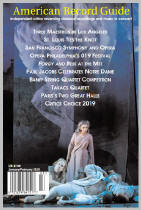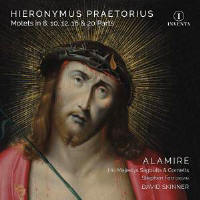Texte paru dans: / Appeared in: |
|
|
Outil de traduction ~ (Très approximatif) |
|
|
Reviewer: Peter
Loewen German composers and their patrons were clearly smitten with the sound of polychoral motets. From Gabrieli’s Venice the style swept into 17th-Century Germany through his students Hans Leo Hassler and Heinrich Schütz. Though Hieronymus Praetorius (1560-1629) appears never to have visited Italy, he nevertheless acquired an expert understanding of the polychoral motet, probably through score study. He compiled his motets in the five-volume Opus Musicum, published in Hamburg from 1599 to 1625. This release includes 16 motets of various dimensions, from 8 to 20 parts. David Skinner claims to offer “a near-complete stylistic snapshot of this relatively unknown northern European master polyphonist”. None of the original parts indicate instrumentation, though Skinner notes that Michael Praetorius’s Syntagma Musicum (1614-20) describes how choral works could be performed in concertato fashion. In light of this advice, Skinner has assigned instruments to various parts of these motets. In fact, ‘Ecce Dominus Veniet’ and ‘Ecce Quam Bonum’ are performed here by an ensemble of 8 cornetts and sackbutts. The singing and playing is outstanding. Praetorius shows a penchant for startling juxtapositions, which the singers and players bring off impressively when alternating the sinuous entanglements of individual voices with walls of chordal sound. Praetorius avoids the stile moderno, which would in later decades pervade Schütz’s Latin and German polychoral music. Only in ‘Dixit Dominus’, the 12-part motet that opens the first disc, does Praetorius show interest in the possibilities of chromatic expression. The 10-part ‘Levavi Oculos Meos’ is an exquisite example of the concertato practice. The treble parts are high, perfectly suited to doubling with cornetts. Suspensions in that range are beautiful, particularly approaching cadences.
Texts and notes are in English. | |
|
|
|
|
Cliquez l'un ou l'autre
bouton pour découvrir bien d'autres critiques de CD |
|




